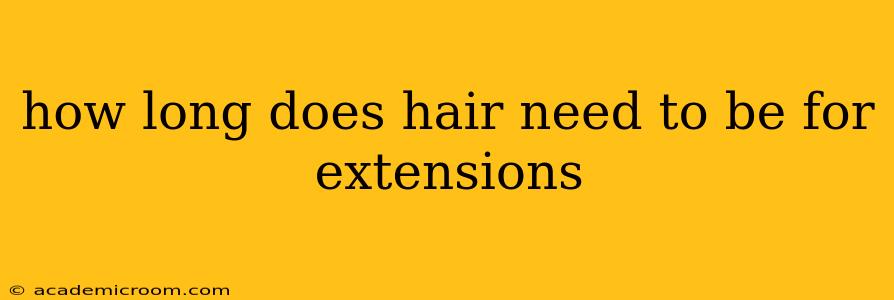Many people dream of luscious, long hair, and hair extensions offer a fantastic way to achieve that look quickly. However, a common question arises: how long does my natural hair need to be before I can get extensions? The answer isn't a simple number, as it depends on several factors, including the type of extensions used and your desired look. Let's delve into the specifics.
What Types of Hair Extensions Are Available?
Before we discuss length requirements, understanding the different extension types is crucial. Each method has its own minimum length needs:
-
Tape-in Extensions: These extensions are applied using adhesive tapes and generally require at least 4-6 inches of natural hair. Shorter hair might not provide enough for secure adhesion, leading to slippage or damage.
-
Sew-in Weave Extensions: This method involves sewing wefts of hair onto cornrows braided close to the scalp. Ideally, you need at least 4-6 inches of hair for a secure weave. Shorter hair may be workable, but the result might not be as full or natural-looking.
-
Fusion/Micro-link Extensions: These individual strands are bonded to your natural hair using a keratin bond or other adhesive. They typically require a minimum of 4 inches, though some stylists may work with slightly shorter hair depending on the hair density.
-
Clip-in Extensions: These are the most versatile and require the least amount of natural hair length. You can use clip-ins with almost any length of hair, as they simply clip onto your existing locks. However, for a seamless blend, having at least 2-3 inches is recommended.
How Much Hair Do I Need for Different Looks?
The length of your natural hair also impacts the overall look and volume you can achieve with extensions.
-
For a subtle boost of volume and length: Even with shorter hair (around 4 inches), you can still achieve a noticeable enhancement, particularly with tape-ins, fusion extensions, or clip-ins.
-
For dramatic length and volume: Achieving a significantly longer and fuller look generally requires longer natural hair (6 inches or more) to provide a secure base and natural blend.
What if My Hair is Shorter Than the Minimum Length?
If your hair is considerably shorter than the recommended minimum length for your preferred extension method, don't despair! You have some options:
-
Wait: The simplest solution is to wait until your hair grows to the required length.
-
Consider other styling options: Explore alternative hairstyles or volumizing products until your hair is long enough for extensions.
-
Consult a professional stylist: A skilled stylist can assess your hair and suggest the best extension method and techniques to minimize risks, even with shorter hair. They might even recommend a more time-consuming method to build up volume gradually.
Can I Use Extensions If I Have Fine Hair?
Yes, you can, but choosing the right extension type is vital. Heavier extensions can weigh down fine hair, so lighter options like tape-ins or micro-links are often preferable. Always consult with a stylist experienced with fine hair to prevent damage.
How Long Does it Take to Grow My Hair Out for Extensions?
Hair grows approximately half an inch per month. Therefore, if you need an additional 4-6 inches, it could take 8-12 months of consistent growth.
What are the risks of using extensions on too-short hair?
Using extensions on hair that is too short can increase the risk of:
- Damage to your natural hair: Pulling, breakage, and even hair loss are possibilities if extensions aren't applied properly.
- Scalp irritation: Improper application can lead to discomfort or irritation on your scalp.
- Unnatural look: If the extensions are not securely attached, they might slip or look uneven.
Remember, consulting a professional stylist is key to achieving the best results and minimizing the risks associated with hair extensions. They can assess your hair's condition, texture, and length to recommend the most suitable extension type and application method. Investing in a skilled professional guarantees a safer and more natural look.
